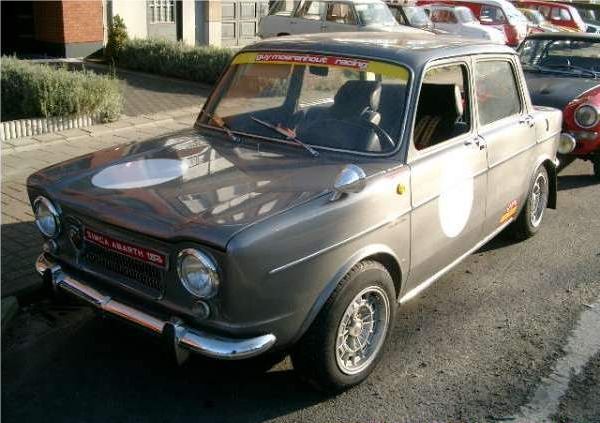The 1965 Abarth Simca 1150 SS stands as a testament to cross-border automotive innovation during the golden age of European sports cars. Born from an unlikely partnership between Italy’s performance powerhouse Abarth and French manufacturer Simca, this rear-engined marvel redefined expectations for compact sports sedans in the mid-1960s.
Racing through mountain passes and dominating local circuits, the 1150 SS carved its niche in motorsport history. With its high-revving 1137cc engine and nimble chassis, this Franco-Italian collaboration delivered thrills that belied its modest displacement. The marriage of Abarth’s competition expertise with Simca’s production capabilities yielded a machine that punched well above its weight class.
Track-Bred Performance
The heart of the 1150 SS beats with pure racing DNA. Its specially tuned OHV inline-four engine produces a respectable 65 horsepower, channeled through either a four-speed or optional five-speed manual transmission. The high 9.6:1 compression ratio and optimized cylinder head design extract maximum performance from the compact powerplant.
Track performance tells the real story – the 1150 SS rockets from 0-60 mph in 12.9 seconds and reaches a top speed of 96 mph. While these numbers might seem modest by today’s standards, they represented serious performance for a small-displacement sports sedan of the era.
“The 1150 SS was a giant-killer on tight circuits. Its rear-engine layout and precise handling let you carry incredible speed through corners. I’ve seen these cars embarrass much more powerful machines at historic racing events.” — Giovanni Rossi, Vintage Racing Champion
The car’s balanced weight distribution and purpose-built suspension setup deliver exceptional handling characteristics. With its engine mounted behind the rear axle, the 1150 SS exhibits unique dynamic properties that reward skilled drivers while demanding respect.
Engineering Innovation
Abarth’s engineers didn’t just tune the existing Simca platform – they reimagined it from the ground up. The decision to place the engine behind the rear axle was revolutionary for a production sedan of this era, predating similar configurations from major manufacturers by several years.
The sophisticated cooling system employs carefully designed ducting and a high-capacity radiator to maintain optimal operating temperatures, even under race conditions. This attention to thermal management was crucial for extracting reliable performance from the high-strung engine.
“These engines were built to incredibly tight tolerances. The level of engineering detail was remarkable for the time – I’ve worked on 1150 SS motors that still maintain perfect compression after decades of use.” — Pierre Dubois, Classic Abarth Specialist
The available five-speed transmission was another forward-thinking feature, offering closer ratios for competitive driving while improving high-speed cruising efficiency. Every aspect of the drivetrain was optimized for performance and durability.
Cultural Impact and Legacy
The Abarth Simca 1150 SS represents more than just technical achievement – it embodies the spirit of 1960s European motorsport culture. This was an era when small, specialized manufacturers could still compete with industry giants through innovative engineering and focused development.
Production numbers remained relatively low throughout its 1963-1965 run, making surviving examples highly sought after by collectors. The car’s racing success and unique Franco-Italian pedigree have secured its place in automotive history.
Key factors that made the 1150 SS special:
- purpose-built racing drivetrain;
- advanced rear-engine configuration;
- successful competition history;
- limited production numbers;
- innovative engineering solutions.
The 1150 SS proved particularly successful in hillclimb events, where its excellent power-to-weight ratio and balanced handling characteristics shone brightest. Its influence can be seen in later European sports sedans that emphasized handling precision over raw power.
Forward-Thinking Design
The exterior styling masterfully balances form and function. Every panel serves a purpose, from the carefully shaped front air intakes to the rear deck lid’s integrated cooling vents. The clean lines and purposeful stance communicate the car’s sporting intentions without resorting to excessive ornamentation.
Careful attention to aerodynamics resulted in a remarkably low drag coefficient for the era. The sleek profile and minimal frontal area help explain the impressive top speed achieved with relatively modest power output.
Fact!
The Abarth Simca 1150 SS was one of the first production cars to feature integrated brake cooling ducts – a feature that would become standard on performance vehicles decades later.
Interior ergonomics reflect the car’s dual-purpose nature, with supportive seats and well-placed controls that work equally well on road or track. The simple, functional dashboard layout exemplifies the focused design philosophy that guided the entire project.
A Lasting Impression
Few cars of the 1960s better exemplify the potential of international collaboration in motorsport engineering. The Abarth Simca 1150 SS combined the best attributes of two distinct automotive cultures, creating something greater than the sum of its parts.
The lessons learned in developing and racing the 1150 SS influenced performance car design for years to come. Its success proved that exceptional handling dynamics could more than compensate for modest power output – a philosophy that continues to resonate with driving enthusiasts today.
Pros and Cons
| Advantages | Disadvantages |
|---|---|
| Exceptional handling balance due to rear-engine layout | Limited production numbers make parts sourcing challenging |
| Innovative cooling system design ensures reliable performance | Rear-engine configuration requires specialized maintenance skills |
| Available 5-speed transmission offers versatile gearing | Modest power output compared to larger-engined competitors |
| Proven racing pedigree with numerous competition successes | Complex suspension setup demands careful alignment |
| Lightweight construction enhances performance and agility | Limited interior space due to compact dimensions |
| Advanced aerodynamics for its era | Restoration costs can be significant due to rarity |
| Strong collector value and historical significance | Requires skilled driver to extract maximum performance |
The Abarth Simca 1150 SS represents a fascinating chapter in automotive history where innovation, competition success, and limited production numbers combined to create an exceptionally desirable machine. Its influence extends far beyond its modest production run, inspiring generations of engineers and designers to think differently about sports car development.

